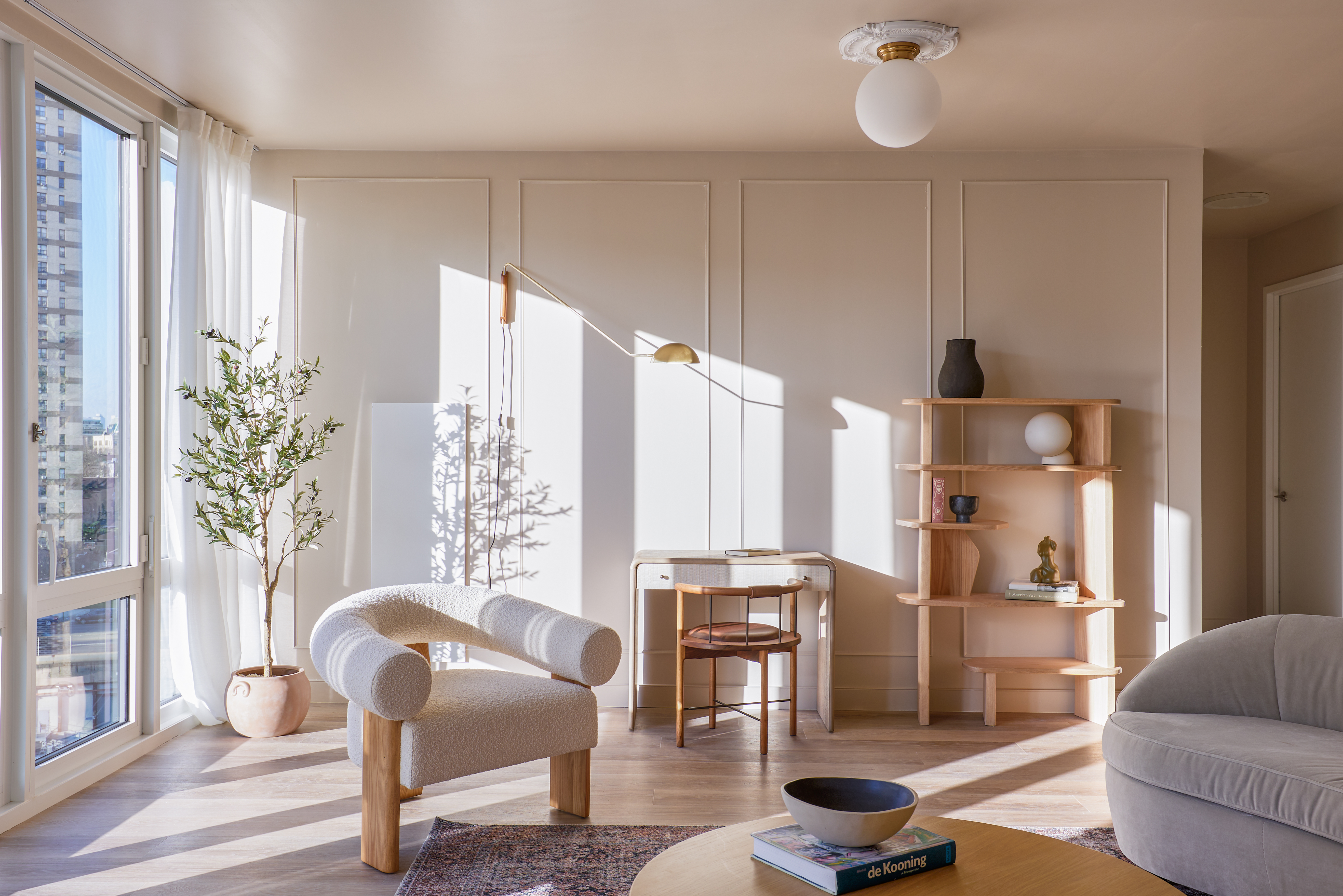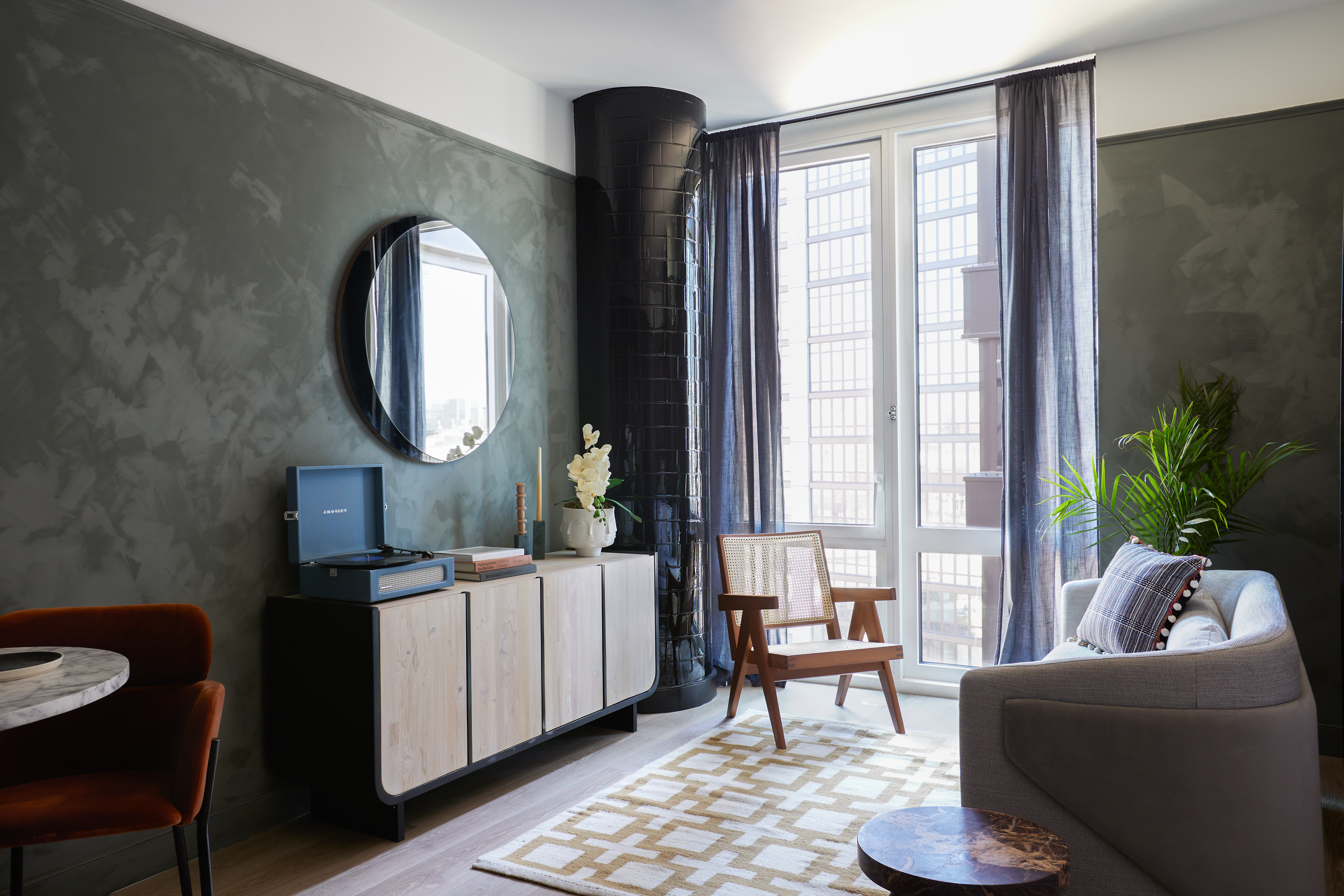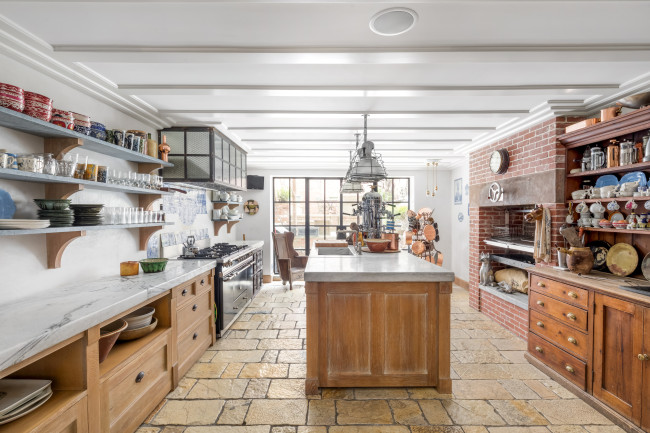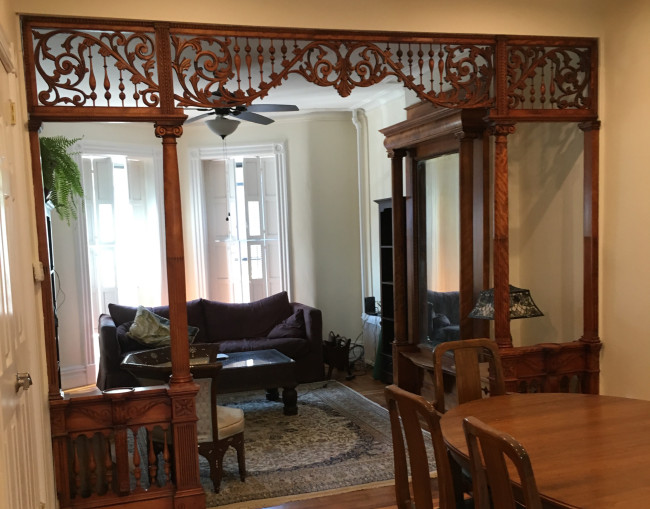If you have prewar taste but live in a plain white box, the Brownstone Boys have some design tips for you
- Brownstone renovators Barry Bordelon and Jordan Slocum did the interiors for model units at 595 Dean St.
- They spent a total of $3,000 on lighting, paint, and molding—easy projects that can be replicated by a renter

Bordelon and Slocum did the interior design for studio and one-bedroom model units at 595 Dean St., a luxury rental project in Prospect Heights.
TF Cornerstone
Lots of renters who move to New York City are disappointed to find out that even the tiniest apartments with quaint, prewar details can be too expensive for their rental budgets.
If you have prewar design tastes but you've landed in a plain vanilla box, you’re not alone. The good news is that there are lots of rental-friendly interior design tricks that can add vintage appeal to a featureless apartment. Two longtime brownstone renovators recently took on a similar design challenge and have some advice to share.
The Brownstone Boys, otherwise known as Barry Bordelon and Jordan Slocum, have done 20 brownstone renovations in Brooklyn and have been featured on on HGTV and The Magnolia Network. (They also have a new book coming out and are getting married—they are partners in work and life.)
Bordelon and Slocum designed the interiors for studio and one-bedroom model units at 595 Dean St. in Prospect Heights, a luxury rental project from developer TF Cornerstone. It was their first interior design project that didn’t involve a brownstone space.
The duo is used to mixing old and new in their projects with the goal of adding modern upgrades to historic homes. For 595 Dean, their plan was to do the opposite: Incorporate vintage details into new construction, which they acknowledge “had more charm than the typical new development.”
Their work involved only cosmetic touches—such as lighting, paint, and molding—simple, not-too-spendy projects that can be undertaken by a renter.
“It was a fun challenge to think how we could make these units homey and stick to a budget,” Bordelon says, adding that they spent a total of $3,000 on materials for both model units. “We couldn’t do anything permanent,” he explains. Funny enough, the units rented right away and the new tenants are keeping the décor intact.
Here are their prewar design tips from 595 Dean as well as other projects that you can replicate in your own rental. Remember it’s a good idea to discuss apartment upgrades with your landlord. Some owners will be fine with you making small changes, others will want you to restore the apartment to its original condition at the end of your lease.

New lighting is a bright idea
Changing your light fixture can transform your space, Bordelon says, especially if your rental light fixture is a dreaded builder-grade “boob light.”
If you want to replicate the look of the lighting in the 595 Dean model units and you have enough height, here’s a similar fixture from Lowe’s available in brushed nickel or vintage gold for $59. Have a little more to spend? We’re partial to schoolhouse-style lighting, like this Mccarthy Milk Glass Flush Mount from Pottery Barn, on sale for $103.
You don’t necessarily need an electrician to swap in a light fixture but you do need to know what you are doing. Still don’t want to do it yourself? Consider paying your super or hiring a handyperson or TaskRabbit to get the job done safely.
Look up to a ceiling medallion
If you’re planning on upgrading your ceiling lighting, consider adding a medallion too.
This plaster decoration found at the base of a ceiling light fixture is a hallmark of prewar apartments. Traditionally made of plaster, you can now find them made of foam, resin and other lightweight materials and sold at a wide number of retailers, including Amazon, Lowe’s, Dykes Lumber Company, and others.
Bordelon says they are partial to ceiling medallions made by Ekena, which come in lightweight materials like wood or PVC and with prices that start at $7. You can find two-piece versions, which are ideal if you don’t want to take your lighting fixture down.

Think texture and warm tones
Bordelon and Slocum opted for warm colors for the walls in the model units, including a dark limewash paint with visible brush strokes. In other rooms, they deployed Dead Salmon, a pinkish-brown tone from Farrow & Ball.
“It’s a small apartment, so we’re bucking the theory that says you can’t do dark walls in a small space,” Bordelon says. The effect is a sense of moodiness that adds character.
If you want to paint the walls in your rental a darker color, be sure to brush up on the rules. Your landlord may require you to repaint the walls in their original color at the end of the lease.
You may be familiar with using peel-and-stick tile to create an instant backsplash, so it’s fun to see how Bordelon and Slocum used it in glossy black to add drama to an interior column.
Add visual interest with moldings and new hardware
The duo added crown molding, picture frame molding, and chair rails and it’s surprising how much character these simple strips of wood add to a room.
Plus, installing molding is “something anyone can do,” Slocum adds. “It’s not nearly as scary as you think” to install.
The chair molding serves double duty. In addition to adding detail to the wall, it serves as a border for the dark wall paint, so the color is not too overbearing. Slocum adds this is the type of treatment you can expect to see in an older home.
Similarly, swapping out cabinet hardware and door knobs for vintage pieces can go a long way toward adding character to a plain space and are easy to do.
Score bonus vintage points with a mantel
This last tip is from a different Brownstone Boys project, a Brooklyn Heights loft renovation, where they installed a vintage mantelpiece to mimic a fireplace.
“This gives the room a historic focal point and brings charm to the space,” Bordelon says. “It makes you feel like you’re in an authentic Brooklyn home,” he says.
You could pay $1,000 for a brand-new marble mantel—or you could do what these two do and head to a salvage yard like Big Reuse in Brooklyn or The Demolition Depot in Harlem, or go online to Mantel House or New York Salvage. Their tip is to look for a painted marble mantel and don’t lose your cool, because it may look ugly.
That’s because historic marble fireplaces are likely to have collected multiple coats of paint over the decades to keep up with changing tastes. It’s hard to imagine the reason why someone would paint marble but the upside is the paint protects the marble. When these painted pieces wind up at salvage yards, most renovators tend to avoid them.
But it turns out it’s not very hard to strip the paint off—you could do it yourself or pay someone a few hundred to do it for you, Slocum says.
You Might Also Like



























